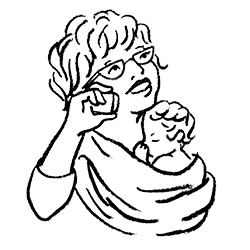COMMON CONDITIONS
Treating Thrush
test
summary
Several factors can cause nipple pain while breastfeeding. Yeast infection, or Candida Albicans, otherwise known as thrush is one cause that can be difficult to diagnose and is often misdiagnosed. Lab tests for Candida Albicans can be unreliable, making a thorough breastfeeding assessment an essential part of a comprehensive diagnosis and treatment plan.
Symptoms of Candida Albicans infection in the breastfeeding parent include:
• Pink nipple or areola area
• Shiny or flaky appearance of the nipple
• Nipple pain and sensitivity even when tissue appears healthy
Symptoms of Candida Albicans infection in the breastfeeding baby include:
• White patches on gums and tongue that are not easily removed
• Discomfort or frustration behaviors while nursing
In treating yeast, both members of a feeding pair must be treated simultaneously, even if one or the other are not showing symptoms.
Equipment:
Prescribed topical medications:
• Azole antifungal ointment or cream for nipples (ex. miconazole, clotrimazole, fluconazole)
• Nystatin suspension or miconazole oral gel for infant’s mouth
Steps:
Your lactation professional can help you speak with your healthcare provider about appropriate protocols and topical medication options to address Candida Albicans. Lactation professional recommendations are based on insights from the Academy of Breastfeeding Medicine.
- Visit a qualified lactation professional to help you protect milk supply as you move to treat the infection with your healthcare provider.
- Visit your healthcare provider to get a prescription for a topical medication, and follow the directions for application and duration of use.
- Alternative treatments such as gentian violet, grapefruit seed extract, coconut oil and more may also offer relief — talk to your healthcare provider about options.
Washing and boiling protocol:
- Wash and sterilize all pump parts, bottles, and pacifiers after each use. Note: Milk collected during treatment for yeast can be fed to your baby, but should not be stored for usage after yeast is resolved. Freezing breastmilk may not kill yeast.
- Wash all bras, pads, night wear, or anything that comes in contact with your nipples.
- Wash any cloth diapers, and consider using disposables until the yeast infection is gone.
Follow Up:
It is recommended to include a qualified lactation professional, and your healthcare provider when a Candida Albicans infection is suspected, diagnosed, and treated. Most people experience relief within 24-48 hours of starting treatment.
Research:
Academy of Breastfeeding Medicine Sore Nipples Protocol (ABM Clinical Protocol #26: Persistent Pain with Breastfeeding)
https://abm.memberclicks.net/assets/DOCUMENTS/PROTOCOLS/26-persistent-pain-protocol-english.pdf
This and other how-to guides are available as free downloads

